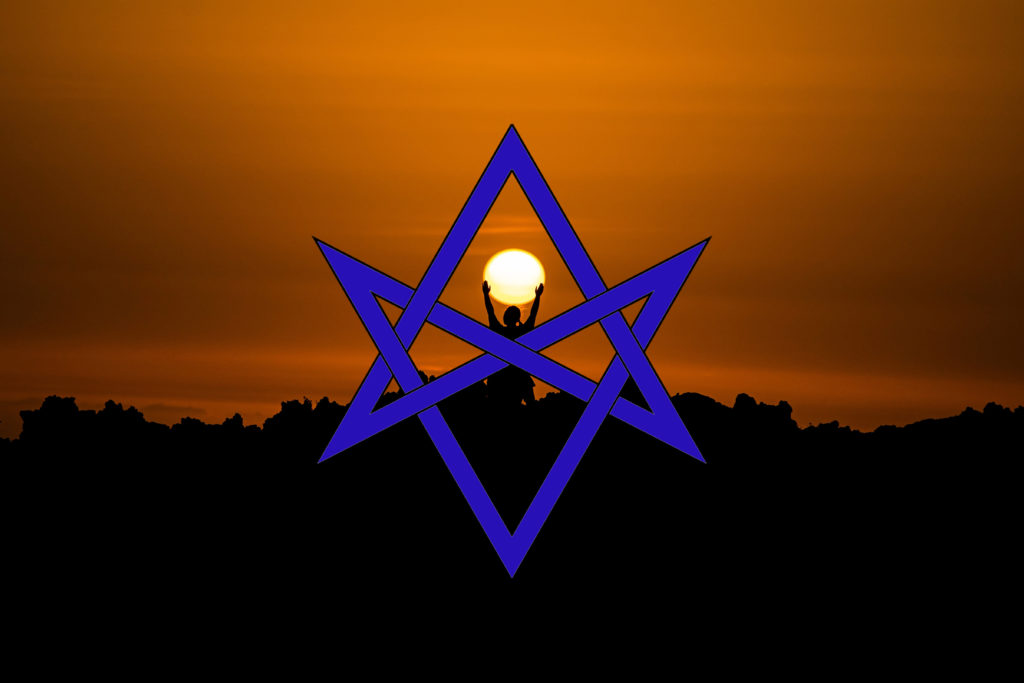Everything is simultaneously shining but also withdrawing into its depth.
Origin of the Kabbalists’ (and Crowley’s) first principle

The idea of “nothingness” as a creative first principle is often assumed to have an “eastern” (e.g., Chinese or Indian) origin. For instance, Pierre Bayle made this claim about the first principle of Kabbalah (Ain) in the 17th century, and Jacob Brucker made a similar claim in the 18th century. Recently I was saw someone remark that Crowley’s opening to the Book of Lies (“Nothing is – Nothing becomes – Nothing is not”) was “Taoist”.
Apparently the idea still has legs!
By Crowley’s own admission, he based his first principle on that of the Kabbalists, but the Kabbalists’ first principle is just the synthesis of two ideas which have been common in the west since antiquity. The first is the idea of creation ex nihilo, a power attributed (controversially) to the God of the Bible (see 2 Maccabees 7:28); the other is the idea that “nothing comes from nothing,” a formulation Aristotle gave to the Principle of Sufficient Reason (see Physics 1.8.191a28).
These ideas were usually seen to contradict one another. For example, Benedict Spinoza’s assertion of the latter principle was taken as proof of his atheism. (Though the aforementioned Pierre Bayle also used it as evidence in favor of Spinoza’s Kabbalism, even though Spinoza seems not to have had any interest in the subject.)
In his Historia Critica Philosophiae, Brucker noted that Kabbalah, “Oriental” thought, and Middle Platonism all shared in common the idea of nothingness as a substantive first principle. From this he concluded that both Kabbalah and Middle Platonism had origins in the east.
A half century or so later, Georg Wilhelm Friedrich Hegel discussed Kabbalah in his Lectures on the History of Philosophy. Interestingly his discussion of Kabbalah occurs in the section on Neoplatonism. He concluded that Philo of Alexandria’s philosophy already contained most of the presuppositions of Kabbalah.
A few noteworthy points:
- Hegel discusses Kabbalah in his Lectures on the History of Philosophy, not in Lectures on the Philosophy of Religion! He regards Kabbalah as philosophy, as do I.
- He recognizes—correctly, I think—that there is nothing necessarily “eastern” about Kabbalah’s first principle. There has been ample fuel in the west since antiquity for thinking of nothingness as a substantive first principle.
- He discusses Kabbalah—again, correctly—as a branch of Neoplatonic thought.
In other words, Hegel is noticing that the esoteric concept of creative nothingness comes from the Platonic tradition, not from Confucianism (as Bayle thought) or from Taoism (as some today have said).
Crowley of course assumes the exact same first principle as the Kabbalists. He even says, “I assert the absoluteness of the Qabalistic Zero.” If you’re looking for a constant in Crowley’s thinking, this was it. He asserts or implies it in Berashith, The Book of Lies, Magick in Theory and Practice, the Book of Thoth, Magick Without Tears, and—yes—the Book of the Law. (See AL I.46 inter alia.)
But Crowley didn’t get the idea from his encounters with eastern schools of philosophy. He states plainly where he got it from. He got it from the exact same place Bayle, Brucker, and Hegel got it: Kabbala Denudata, which Samuel Mathers translated into English in 1887 (with a lengthy introduction) and used as one of the bases of the work of the Hermetic Order of the Golden Dawn.
Crowley didn’t just take this principle over, though. He applied it rigorously in a way I doubt Mathers ever did but which in some ways parallels Hegel’s use of it. And so it is infused throughout Thelema. Here’s just one example among many:
Thou must (1) Find out what is thy Will. (2) Do that Will with a) one-pointedness, b) detachment, c) peace.
—Liber II: The Message of The Master Therion
Then, and then only, art thou in harmony with the Movement of Things, thy will part of, and therefore equal to, the Will of God. And since the will is but the dynamic aspect of the self, and since two different selves could not possess identical wills; then, if thy will be God’s will, Thou art That.
The will is the dynamic aspect of the true self, Hadit. But Hadit is not the personality. Hadit is impersonal (i.e., indeterminate) identity. Another way to say “indeterminate” is “not-a-thing”. So to take up the standpoint of Hadit is to take up the standpoint of the first principle of Thelemic philosophy—but this is just the substantive nothingness which the Kabbalists called “Kether” or “Ain,” or God in His most esoteric form.
If the principle is essential to Crowley’s understanding of true will and his solution to the problem of determinism versus free will, then it’s obviously foundational to his thought in general.
Another reason to practice Liber Resh

In the Platonic tradition, the Sun is a symbol of unity. It is the visible and sensible analog of the One Itself which gives unity in the purely intelligible realm. This One Itself transcends being and non-being. In fact it transcends all opposition whatsoever and is the sole cause of anything being whatever it is. For this reason it is also called the Good Itself.
The equivalent of the One in Thelema is Kether, which is also associated with Ra-Hoor-Khuit. Speaking in the 1st Aethyr of The Vision and the Voice, Ra-Hoor-Khuit declares:
I am light, and I am night, and I am that which is beyond them.
I am speech, and I am silence, and I am that which is beyond them.
I am life, and I am death, and I am that which is beyond them.
I am war, and I am peace, and I am that which is beyond them.
I am weakness, and I am strength, and I am that which is beyond them.
Yet by none of these can man reach up to me. Yet by each of them must man reach up to me.
The unity of opposites represented by Ra-Hoor-Khuit transcends both our capacity of reasoning as well as our capacities of sensation or intuition. Nevertheless, the Sun serves as a visual analog of this transcendent principle, much as it did for the Platonists. Thus four times a day, Thelemites turn toward the Sun and cry aloud:
Unity uttermost showed!
It is necessary to put ourselves into contact with transcendent unity, because as conditioned beings, we do not contain unity within ourselves.
Everything that we are or could even know—about ourselves or about the world—falls into five “heaps” or khandhas. We know by means of sensible impressions (rupa); the pleasure, displeasure, or boredom arising from them (vedana); perceptions (samjna); habituated tendencies (sankhara); and consciousness (vijnana). Each of these arises and passes beyond our control. Insofar as any of these abide for awhile, they change constantly. Therefore they are unreliable, and none can be said to be a self, to contain a self, to be under the control of a self, or to be in a self. None can provide lasting happiness. Even consciousness comes and goes throughout the day, when we fall asleep, or when we die.
For this reason, Crowley declared that the principle of unity of each person—as represented by their spiritual Sun, their Holy Guardian Angel—could not be found by means of introspection.
Apart from any theoretical speculation, my Sammasiti and analytical work has never led to so much as a hint of the existence of the Guardian Angel. He is not to be found by any exploration of oneself.
Magick without Tears, Chapter 43
And yet achieving unity is the preeminent goal of Thelemic ethics.
A Man whose conscious will is at odds with his True Will is wasting his strength. He cannot hope to influence his environment efficiently.
(Illustration: When Civil War rages in a nation, it is in no condition to undertake the invasion of other countries. A man with cancer employs his nourishment alike to his own use and to that of the enemy which is part of himself. He soon fails to resist the pressure of his environment. In practical life, a man who is doing what his conscience tells him to be wrong will do it very clumsily. At first!)
Magick in Theory and Practice, Introduction
Therefore turning toward the Sun four times a day is not a mere religious observance. It serves an important spiritual and ethical purpose.
By turning toward the Sun, we first admit that unity is not automatically present within us. As far as we have come in life, we still have work to do on ourselves. The process is continual. We can always improve.
Second, we recognize that the principle of unity—hence the principle of self-subsistence and enduring happiness—transcends who we ordinarily take ourselves to be. We recognize that when we identify with the skandhas, we’re like a person trying to build a house on quicksand.
Thelemites sometimes talk about the difference between the small-s self, which we identify with our egos, versus the big-s Self, which we identify with Jechidah or the Holy Guardian Angel. In fact there is only one self to speak of, since what we call “self” (with the small-s) is merely an illusion. When we turn toward the Sun, we allow its radiance to dispel this illusion all together, so that our entire being can enjoy contact with that which truly deserves to be called self.
He is the Open Eye of the exalted Sun, before whom all shadows flee away: also that Secret Eye which makes an image of its God, the Light, and gives it power to utter oracles, enlightening the mind.
Magick in Theory and Practice, Chapter 5
I adore the might of Thy breath,
AL III.37
Supreme and terrible God,
Who makest the gods and death
To tremble before Thee—I, I adore thee!
And then finally, having recognized the true source of unity beyond becoming, beyond opposition, we learn to surrender ourselves to it. Gradually we come to see ourselves as instruments or extensions of it. The more frequently we reestablish conscious contact with this spiritual unity or Jechidah, the easier and more habitual it is for us to find that lifeline and source of spiritual power in difficult times. We learn to tolerate misfortune with equanimity, knowing that even in the darkest hour, a radiant god stands at our backs.
And should we follow that lifeline back to its source, any one of us can pass through that “secret door / Into the house of Ra and Tum, of Khephra and of Ahathoor” and attain to direct awareness of that “center and secret of the Sun” which Crowley himself knew in his most exalted visions.


